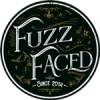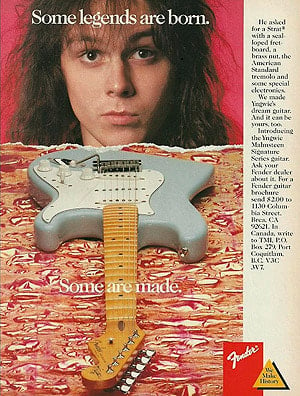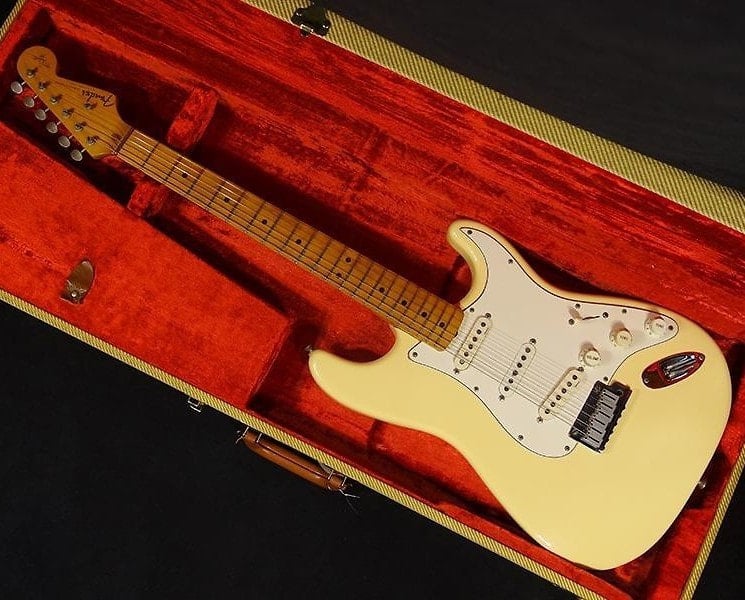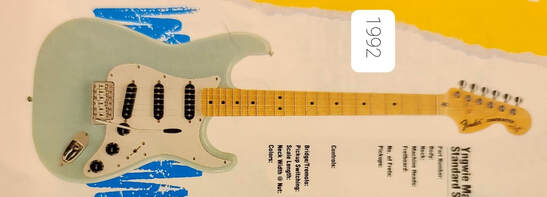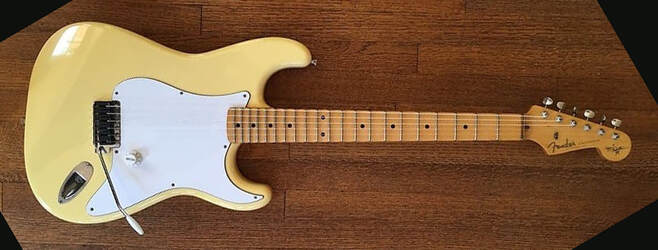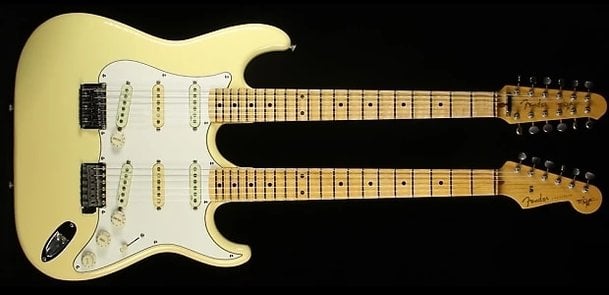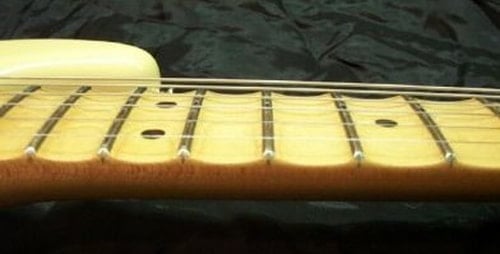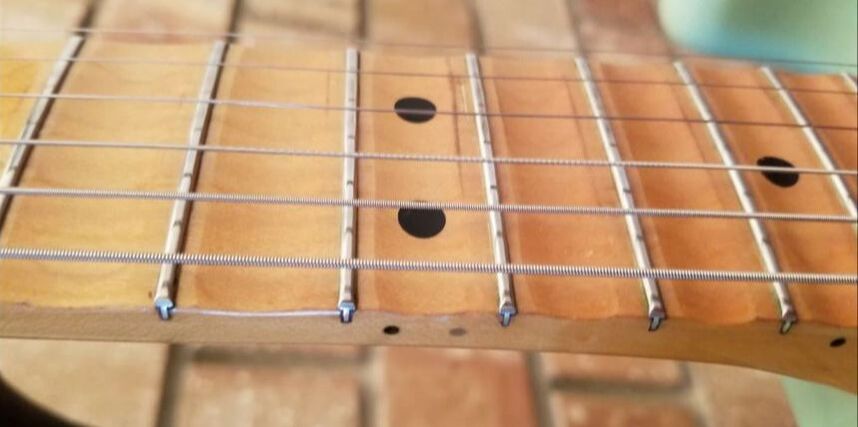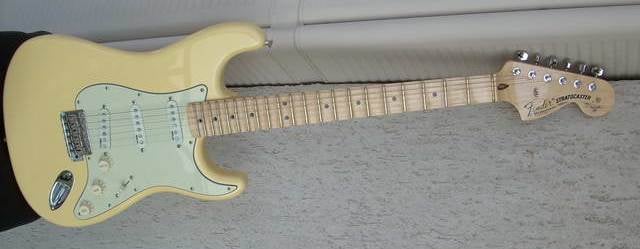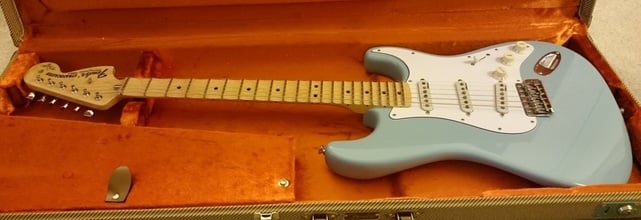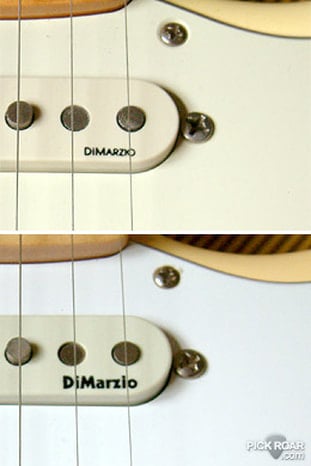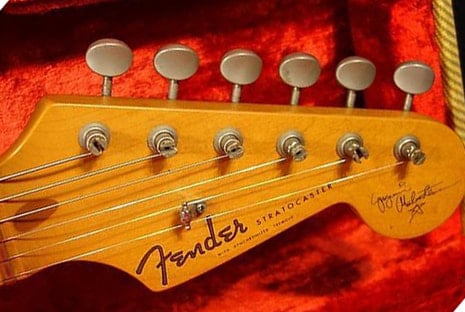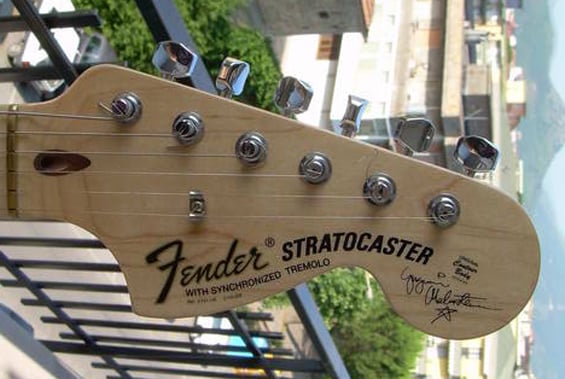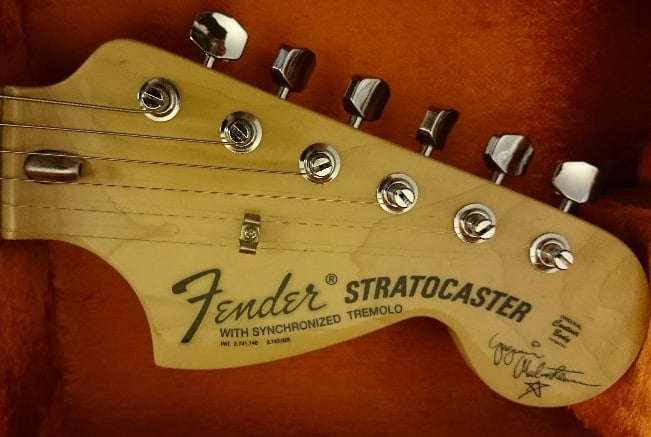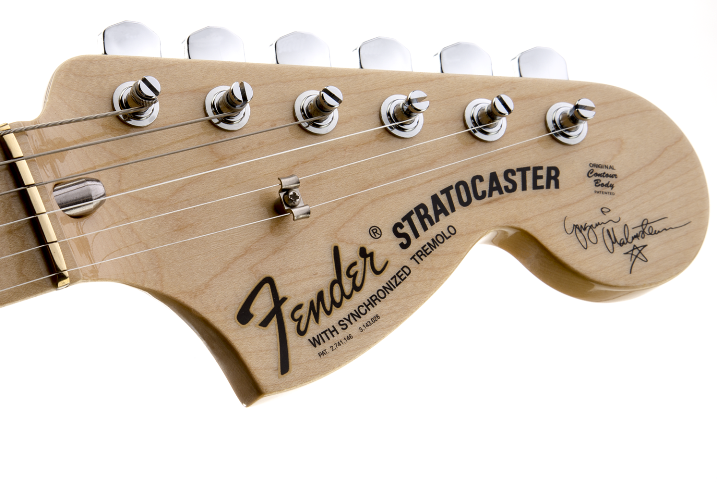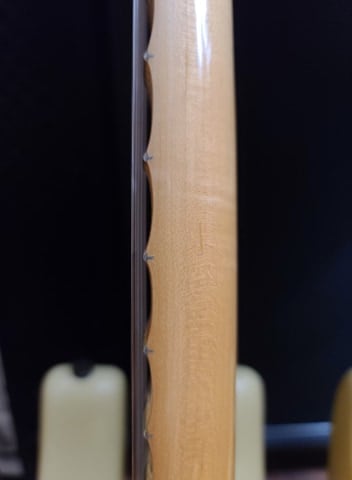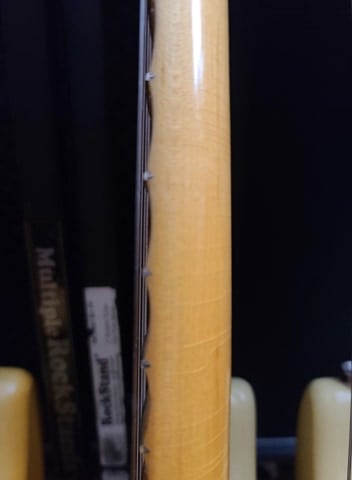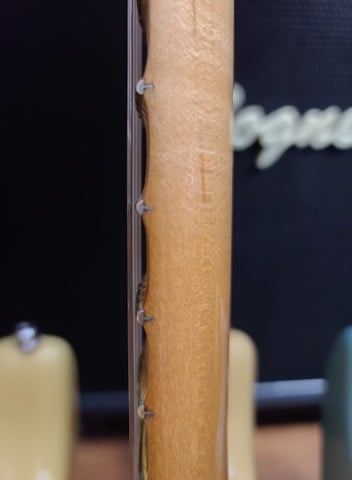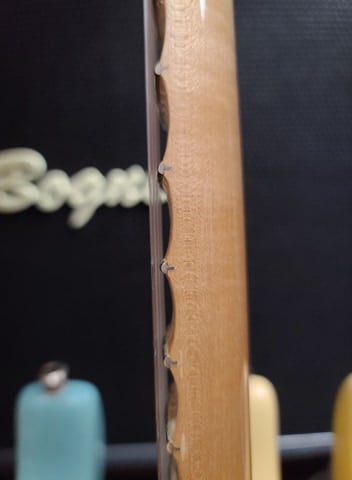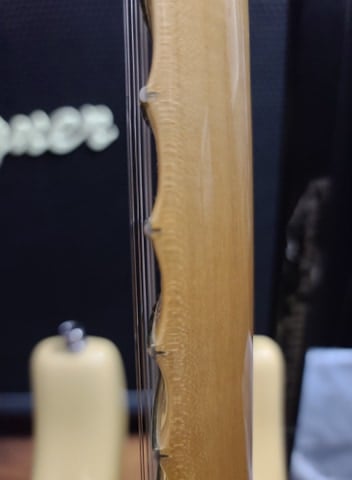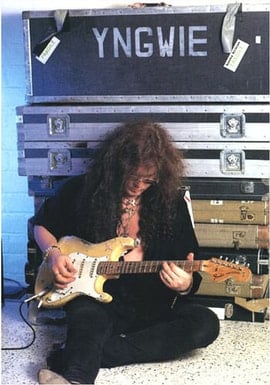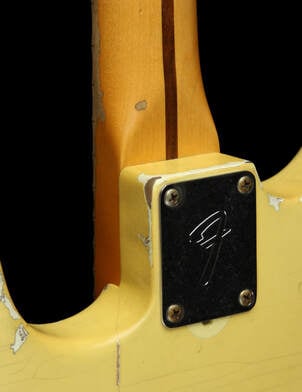THE ORIGIN OF THE mALMSTEEN sTRATOCASTER
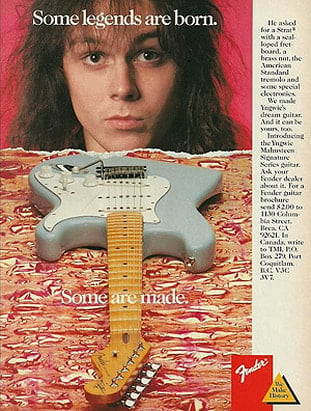 YJM Stratocaster advert, Fender Frontline
YJM Stratocaster advert, Fender Frontline
The Yngwie Malmsteen Stratocaster, also called YJM Stratocaster, was the second signature model Stratocaster made by Fender. George Blanda started to work on this project in November 1986, two months before Michael Stevens and John Page arrived at the Corona factory to organize the Custom Shop. In that period the development of the American Standard and Clapton Stratocaster was at an advanced stage.
It's interesting to note that this wasn't the first Yngwie signature guitar. In fact, in 1986 Schecter built a couple of custom guitars for him with contoured bodies, scalloped fretboards and reverse headstocks, and produced a model named Schecter YM-1.
George Blanda remembers that he and Dan Smith met the Swedish guitarist after his concert on Long Island to decide the specs of the guitar together. “Let me show you something that you obviously have forgotten!”, Yngwie said, showing the two Fender men his vintage Stratocaster body contours. George and Dan had brought some American Standard Strats with them that the guitarist liked a lot; in particular, Yngwie appreciated the new 2-Point Tremolo, which he decided to mount also on his signature model. However the guitarist asked them to change the contour of the Stratocaster body, which in that period featured the soft lines of the last “Fullerton era”, with a more squared one that, subsequetntly, Fender adopted for the American Standards made in the Corona factory.
In January 1987 all the notes of George Blanda and Dan Smith arrived at John Page’s and Michael Stevens’s Custom Shop (which hasn’t been officially announced yet) for the construction of the new prototype; however, the production of the new Stratocaster started only towards the end of the year. If you think about Malmsteen’s technique and virtuosities, you might expect a guitar based on a Superstrat, as those were fashionable among the guitarists of the '80s. Instead, the starting points of this signature were the most classic among the Stratocasters, as George Blanda stated: “Yngwie is a traditionalist in many ways. It was important to him that all the Strat body contours matched those of his '50s Strats. But the neck was something else. Scalloped fingerboards are an integral part of his techniques. So for him it had to have the vintage look with his special neck.”
In fact, Malmsteen, inspired by his guitar hero, Blackmore, had lowered the central pickup (which he didn’t use) to the pickguard level on his personal guitars and, together with his technician, had dug the wood between the frets, because he was persuaded that this, by subjecting the fingers to less friction, would have allowed to play faster: “The idea of a scalloped fretboard is that, because you’re not going all the way down to the wood when fretting, you can play with a lighter touch. This means less effort for each note, and less tensio, and if you’re a fan of my blog, you’ll know how bad tension can be for your playing! It also means less friction when bending notes, as the string is only going along a smooth fret and not the wood of the fretboard.” It was therefore obvious that his signature would have a scalloped fretboard.
It's interesting to note that this wasn't the first Yngwie signature guitar. In fact, in 1986 Schecter built a couple of custom guitars for him with contoured bodies, scalloped fretboards and reverse headstocks, and produced a model named Schecter YM-1.
George Blanda remembers that he and Dan Smith met the Swedish guitarist after his concert on Long Island to decide the specs of the guitar together. “Let me show you something that you obviously have forgotten!”, Yngwie said, showing the two Fender men his vintage Stratocaster body contours. George and Dan had brought some American Standard Strats with them that the guitarist liked a lot; in particular, Yngwie appreciated the new 2-Point Tremolo, which he decided to mount also on his signature model. However the guitarist asked them to change the contour of the Stratocaster body, which in that period featured the soft lines of the last “Fullerton era”, with a more squared one that, subsequetntly, Fender adopted for the American Standards made in the Corona factory.
In January 1987 all the notes of George Blanda and Dan Smith arrived at John Page’s and Michael Stevens’s Custom Shop (which hasn’t been officially announced yet) for the construction of the new prototype; however, the production of the new Stratocaster started only towards the end of the year. If you think about Malmsteen’s technique and virtuosities, you might expect a guitar based on a Superstrat, as those were fashionable among the guitarists of the '80s. Instead, the starting points of this signature were the most classic among the Stratocasters, as George Blanda stated: “Yngwie is a traditionalist in many ways. It was important to him that all the Strat body contours matched those of his '50s Strats. But the neck was something else. Scalloped fingerboards are an integral part of his techniques. So for him it had to have the vintage look with his special neck.”
In fact, Malmsteen, inspired by his guitar hero, Blackmore, had lowered the central pickup (which he didn’t use) to the pickguard level on his personal guitars and, together with his technician, had dug the wood between the frets, because he was persuaded that this, by subjecting the fingers to less friction, would have allowed to play faster: “The idea of a scalloped fretboard is that, because you’re not going all the way down to the wood when fretting, you can play with a lighter touch. This means less effort for each note, and less tensio, and if you’re a fan of my blog, you’ll know how bad tension can be for your playing! It also means less friction when bending notes, as the string is only going along a smooth fret and not the wood of the fretboard.” It was therefore obvious that his signature would have a scalloped fretboard.
The first series of his new signature model was equipped with Di Marzio HBS-3 pickups at the neck and bridge and an American Standard Strat pickup, reverse winding/reverse polarity and lowered to the pickguard level, in central position. The Di Marzio HBS-3 pickups were stacked coil as the two coils were one above the other, unlike what happens in the humbuckers in which they are placed side by side; yet like those they are hum-cancelling, while maintaining the typical sound of the single coils.
A tremolo bridge like that of the American Standards, a special “U” shaped neck with a vintage style truss rod and a TBX tone control were other distinctive features of the first series. The Swedish guitarist also required a brass nut to make the sound slightly brighter and slide the strings better. At first Fender found the request too expensive, but in the end Yngwie was satisfied. The instrument was available with either a maple or rosewood fretboard. The available finishes were Sonic Blue, Candy Apple Red and Vintage White (much more yellowish than expected).
Fender described the initial Yngwie Malmsteen Stratocaster with these words: “Swedish guitarist Yngwie Malmsteen first hit the U.S. music scene through a Guitar Player Spotlight column and from there, hit the ground running. From his days in the 80’s rock scene to sold-out performances showcasing his classical influences and prodigious technique, Yngwie has remained truly one of a kind”. It is curious to note how the photos of the prototypes, used for the presentation of the new signature, exhibited an 11-hole (one screw above the central pickup) pickguard, while the Malmsteen Stratocasters that entered the market had still an 11-hole pickguard, but in the pre-1963 configuration. And not only that: the first tuning machines were Di Marzio branded, replaced by Kluson style ones during 1989.
A tremolo bridge like that of the American Standards, a special “U” shaped neck with a vintage style truss rod and a TBX tone control were other distinctive features of the first series. The Swedish guitarist also required a brass nut to make the sound slightly brighter and slide the strings better. At first Fender found the request too expensive, but in the end Yngwie was satisfied. The instrument was available with either a maple or rosewood fretboard. The available finishes were Sonic Blue, Candy Apple Red and Vintage White (much more yellowish than expected).
Fender described the initial Yngwie Malmsteen Stratocaster with these words: “Swedish guitarist Yngwie Malmsteen first hit the U.S. music scene through a Guitar Player Spotlight column and from there, hit the ground running. From his days in the 80’s rock scene to sold-out performances showcasing his classical influences and prodigious technique, Yngwie has remained truly one of a kind”. It is curious to note how the photos of the prototypes, used for the presentation of the new signature, exhibited an 11-hole (one screw above the central pickup) pickguard, while the Malmsteen Stratocasters that entered the market had still an 11-hole pickguard, but in the pre-1963 configuration. And not only that: the first tuning machines were Di Marzio branded, replaced by Kluson style ones during 1989.
mALMSTEEN sTRATOCASTERS MADE IN jAPAN
Between the 1990 and 1994 Fender Japan exported the Yngwie Malmsteen Standard Stratocaster, which differed from the American version, by the '70s style big headstock with Gotoh cast/sealed tuning machines, basswood body, the differently scalloped fretboard, “U” shaped and gloss finished neck, different pickups, no TBX and black pickup covers, switch tip, tremolo arm tip and knobs. In 1990 the bridge was the 2-Point American Standard tremolo, which was replaced by a CBS style bridge from 1991 to 1994. A few models were in a Surf Green finish (not faded Sonic Blue), although this color was never advertised in the Fender catalogs.
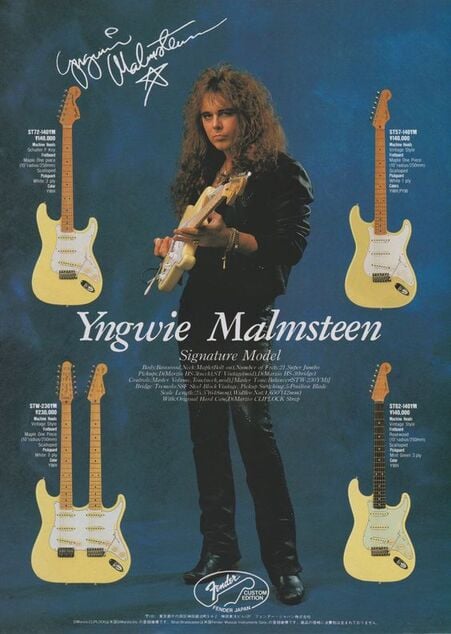 '90s Yngwie Malmsteen Japanese domestic models advert. In this picture you can see the Custom Edition Logo, the same that stood out ion the back of the headstock of the first Japanese YJM strats.
'90s Yngwie Malmsteen Japanese domestic models advert. In this picture you can see the Custom Edition Logo, the same that stood out ion the back of the headstock of the first Japanese YJM strats.
In 1994 other YJM signature strats made in Japan, intended for the Japanese market only, appeared. They had basswood bodies, scalloped fretboards, vintage style tuning machines and only one string tree, and remained in production for many years.
The ST57-140YM, ST62-140YM and ST72-140YM were high-end instruments, made by the Japanese Custom Edition Team, as evidenced by the logo behind the headstock.
The '57 and the '62 had the '50s style small headstock, while the '72 had the large CBS style one.
The '62 was the only Malmsteen signature made in Japan with a rosewood fingerboard.
The ST68-185YM (later also called ST68-YJM) and the ST71-140YM (also called ST71-150YM and ST71-YJM based on manufacturing years) were produced between the late '90s and 2010. The '68 was the first of the Japanese Malmsteen Stratocasters to experiment with the new anchor mounted neck joint - even before the American signature models - and the only one that featured a maple cap fingerboard.
The last Yngwie Malmsteen Stratocasters intended for the Japanese market to be produced were the ST-YJM, which replaced the '68 and '71 between 2011 and 2014, and the Yngwie Malmsteen Strat, since 2015.
Other Yngwie Mamsteen signature models produced in the '90s and intended for the Japanese domestic market only were a Stratocaster with nylon strings, the STCL-140YM, and a double neck model, the STW-230YM.
It is interesting to note that in Japan other domestic Stratocasters with scalloped fretboards but without Malmsteen’s signature on the headstock were made, usually dubbed YJM pre-signature Stratocaster.
The ST57-140YM, ST62-140YM and ST72-140YM were high-end instruments, made by the Japanese Custom Edition Team, as evidenced by the logo behind the headstock.
The '57 and the '62 had the '50s style small headstock, while the '72 had the large CBS style one.
The '62 was the only Malmsteen signature made in Japan with a rosewood fingerboard.
The ST68-185YM (later also called ST68-YJM) and the ST71-140YM (also called ST71-150YM and ST71-YJM based on manufacturing years) were produced between the late '90s and 2010. The '68 was the first of the Japanese Malmsteen Stratocasters to experiment with the new anchor mounted neck joint - even before the American signature models - and the only one that featured a maple cap fingerboard.
The last Yngwie Malmsteen Stratocasters intended for the Japanese market to be produced were the ST-YJM, which replaced the '68 and '71 between 2011 and 2014, and the Yngwie Malmsteen Strat, since 2015.
Other Yngwie Mamsteen signature models produced in the '90s and intended for the Japanese domestic market only were a Stratocaster with nylon strings, the STCL-140YM, and a double neck model, the STW-230YM.
It is interesting to note that in Japan other domestic Stratocasters with scalloped fretboards but without Malmsteen’s signature on the headstock were made, usually dubbed YJM pre-signature Stratocaster.
malmsteen strats: 2Nd, 3th and 4th series
 Since 2007 the US Malmsteen Strat neck was fixed to the body by the machine screw neck mountig, still used for the Japanese ST68-185YM Malmsteen Stratocaster
Since 2007 the US Malmsteen Strat neck was fixed to the body by the machine screw neck mountig, still used for the Japanese ST68-185YM Malmsteen Stratocaster
Fender modified the Yngwie Malmsteen Stratocaster three times: in 1998, 2007 and 2011. Though some distinctive features, such as the scalloped fretboard - which since 2007 became more pronounced, especially in the final part, and the brass nut - that since 2007 was lowered to improve the action, were maintained, the new series were quite different from the 1988 one. The big headstock in CBS style wanted by Malmsteen, who was persuaded that it would increase sustain, the much larger frets, and the new Di Marzio YJM pickups in central position and at the neck (while the Di Marzio HS-3 was maintained at the bridge) were introduced. In 1998 the BiFlex truss rod appeared on the headstock and, since 2007, the Bullet truss rod; the frets became much larger, the butterfly string tree replaced the Ezy Glider one and the 6-point Synchronized Tremolo took the place of the 2-Point Tremolo. The pickup selector went from 5 to 3-way, the TBX was removed and the No Load Control was introduced which allowed players to completely exclude the tone control from the circuit when the knob was in position 10 and, according to the Swedish guitarist, it could slightly increase the output of the pickups.
In the Second Series of 1998 the pickguard changed to Mint Green and the position of the screws was modified to the modern configuration; since 2007, with the Third Series, Fender had opted for a clearer aged white pickguard and a Vintage White finish, appearing even more yellow than the previous version. Moreover, since 2007 Malmsteen Stratocaster neck had been anchored to the body through the Machine Screw Neck Mounting Inserts, sort of metal inserts placed inside the neck.
In the Second Series of 1998 the pickguard changed to Mint Green and the position of the screws was modified to the modern configuration; since 2007, with the Third Series, Fender had opted for a clearer aged white pickguard and a Vintage White finish, appearing even more yellow than the previous version. Moreover, since 2007 Malmsteen Stratocaster neck had been anchored to the body through the Machine Screw Neck Mounting Inserts, sort of metal inserts placed inside the neck.
In 2011 the stacked coil Seymour Duncan YJM Fury pickups took the place of the Di Marzio ones. These pickups were designed in collaboration with Malmsteen himself, who, after having tested about twenty prototypes, found the desired sound in them.
Comparison of the headstocks of the four American versions. Only the third and the fourth US model had the bullet truss rod; the first series had the vintage style truss rod from the headstock, while the second series featured the Bi Flex truss rod. The first series also stood out for its Kluson-style tuning machines and for the Ezy Glider string tree, which in the other series is replaced by a butterfly one.
Info About Scallop Depths, by Brandon Breeze, owner of the Yngwie Malmsteen Guitar Enthusiasts Facebook Group:
Comparison made by Brandon Breeze between US YJM fretboards. The scallops on the US models got deeper with each new model. The first US model had the most shallow scallops and also smaller frets.
US Version 1 evenly shaped shallow scallops
US Version 2 deeper scallops with a different shape, goes deep quickly then flattens out
US Version 3 evenly shaped deep scallops, like version 1 just deeper
US Version 4 deepest scallops similar to version 2, but deeper
MIJ 57/62/71/72 evenly shaped scallops like US V1, but have Jumbo Frets, so they seem deeper
MIJ 68 depth similar to US V1, but more of a v shape, especially the upper frets
MIJ "Standard" Export, terrible scallops, not deep, has ledges on most frets, vintage frets. Kinda defeats the purpose
Comparison made by Brandon Breeze between US YJM fretboards. The scallops on the US models got deeper with each new model. The first US model had the most shallow scallops and also smaller frets.
US Version 1 evenly shaped shallow scallops
US Version 2 deeper scallops with a different shape, goes deep quickly then flattens out
US Version 3 evenly shaped deep scallops, like version 1 just deeper
US Version 4 deepest scallops similar to version 2, but deeper
MIJ 57/62/71/72 evenly shaped scallops like US V1, but have Jumbo Frets, so they seem deeper
MIJ 68 depth similar to US V1, but more of a v shape, especially the upper frets
MIJ "Standard" Export, terrible scallops, not deep, has ledges on most frets, vintage frets. Kinda defeats the purpose
Custom Shop guitars
The Custom Artist Model
In 2019 the Custom Shop unveiled its Custom Artist version of the signature, named Yngwie Malmsteen Signature Stratocaster, which differed from the factory in the select alder and nitro finished body and for a maple cap, obviously scalloped, and Custom “C” contoured neck.
The Play Loud
In late 2008 Custom Shop master builders made 100 Yngwie Malmsteen Tribute Stratocasters, relying on the 1971 Stratocaster of the Swedish guitarist, also called Play Loud or The Duck due to some of the many adhesives applied (and sometimes also removed) during the years on the original guitar, among which the white one on which was written by hand "PLAY LOUD" or the faded one depicting the Ferrari symbol in the back of the body.
The Play Loud exhibited, it the beginning, an Olympic White finish which over time had definitely turned yellow and showed many signs of wear, accumulated after years of recording and live performances (it was retired in 1992), the reason Master Builder Jason Smith described it “one of the most beat-to-crap guitars I've ever seen in my life. That thing had seen a lot of abuse.”
The fretboard was scalloped by Yngwie himself when he was fifteen, although the result was not optimal and John Cruz defined it “crude, not too pretty.”
The 4-bolt neck plate was characteristic of the Play Loud; it was attached to a guitar born with a 3-bolt with tilt-neck, so it was possible to see at the base of the plate the original hole for the Micro-Tilt; the neck pocket no longer had the metal disc for adjusting its inclination and the hole was professionally filled with wood.
The electronics were very special. It featured the Di Marzio HS3 prototypes at the neck and bridge, although it had previously used other pickups too, like the Di Marzio FS1, while at the center the guitar featured a '70s stock pickup that Yngwie had completely disconnected. Also the tone controls had been detached from the circuit: “The circuit is basically the neck and the bridge pickups, a volume control, the output, and that's it,” as John Cruz stated in an interview with Guitar World.
The Play Loud exhibited, it the beginning, an Olympic White finish which over time had definitely turned yellow and showed many signs of wear, accumulated after years of recording and live performances (it was retired in 1992), the reason Master Builder Jason Smith described it “one of the most beat-to-crap guitars I've ever seen in my life. That thing had seen a lot of abuse.”
The fretboard was scalloped by Yngwie himself when he was fifteen, although the result was not optimal and John Cruz defined it “crude, not too pretty.”
The 4-bolt neck plate was characteristic of the Play Loud; it was attached to a guitar born with a 3-bolt with tilt-neck, so it was possible to see at the base of the plate the original hole for the Micro-Tilt; the neck pocket no longer had the metal disc for adjusting its inclination and the hole was professionally filled with wood.
The electronics were very special. It featured the Di Marzio HS3 prototypes at the neck and bridge, although it had previously used other pickups too, like the Di Marzio FS1, while at the center the guitar featured a '70s stock pickup that Yngwie had completely disconnected. Also the tone controls had been detached from the circuit: “The circuit is basically the neck and the bridge pickups, a volume control, the output, and that's it,” as John Cruz stated in an interview with Guitar World.
Antonio Calvosa
